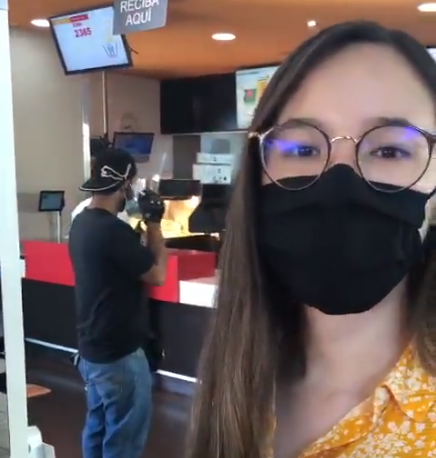
Hyperbitcoinization began in El Zonte. Since El Salvador declared bitcoin legal tender, the little town also known as Bitcoin Beach became a pilgrimage point for bitcoiners everywhere. That’s what this publication’s From The Ground series is all about. First-hand experiences, directly from the center of the volcano.
So far, we’ve brought you the Dutch, Salvadoran One and Two, French, North American One and Two, Italian, and Austrian perspectives on El Salvador’s bitcoin experiment. Now, it’s time for a Brazilian woman to offer her view of the situation. The thing is, Saori Honorato is a journalist.
In her article “Bitcoin Beach Trip: What life is like in the place that started a revolution in El Salvador,” she turns the camera around. Instead of offering her perspective, she interviews five El Zonte residents from different walks of life. What do the people most affected and benefited from bitcoin adoption think about the situation? Keep reading to find out.
No McDonald's de El Salvador dá pra pagar a conta com #bitcoin
Através da Lightning Network a transação acontece de forma instantânea e sem custo!
É o futuro! 🚀🚀🚀🚀 pic.twitter.com/py832HOV2R
— Saori Honorato (@saorihonorato) November 20, 2021
Saori Honorato provides the setting:
“On that small beach inhabited by about 3,000 people, what prevails is the social role of a free technology that guarantees those Salvadorans access to the financial system that has always excluded them.”
And then, she starts listening to what El Zonte residents have to say.
El Zonte Resident #1: Maria de Carmen, 51
She owns a little store and is “part of 70% of the population of the small country that does not have access to the traditional financial system.” Bitcoin adoption has been good to her, “My story with bitcoin is that I started to have things that I could never have before.” She began accepting bitcoin payments and ten months later, “I can say that my life is better because of it.”
Even though María de Carmen sold “$530 worth of bitcoin” to “buy a refrigerator,” she evolved into a holder. Her part of the story ends with, “she prefers not to use the currency to pay other people and, thus, be able to preserve her savings.”

BTC price chart for 03/19/2022 on Gemini | Source: BTC/USD on TradingView.com
Resident #2: Maíra Caroline Flores, 30
For her part, Maíra “was on the street preparing pupusas dough, the most traditional dish in the country, to sell at the beach fair that night.” Bitcoin is too complicated for this pupusa merchant. “I can’t use it, honestly. When I need someone, someone always helps me. I know how to use a normal cell phone, the problem is that the wallet is complicated,” she said.
Whenever she manages to get a bitcoin payment, she rushes to the ATM to exchange it for cash. “I prefer dollars,” Maíra stated breaking all of our hearts.
Ontem estive na "praia do bitcoin" na região de El Zonte (El Salvador).
O #bitcoin começou a ser usado na praia após a comunidade receber uma doação anônima de BTC em 2019
Por lá dá pra comprar de tudo com bitcoin… água de coco na praia, artesanato e as tradicionais pupusas pic.twitter.com/sgxzYX6ll5
— Saori Honorato (@saorihonorato) November 19, 2021
El Zonte Resident #3: Luis Morales, Hope House volunteer
The legendary Hope House, El Zonte’s neural center. The organization’s general goal is “to give beach kids reasons to stay in the country.” Morales expands on the idea:
“They go to school a little bit but when they grow up, they prefer to work. The problem is that jobs are scarce here depending on the season. So we are trying to teach English and teach them how to use the computer so that they can offer their services abroad without having to leave the country.”
About bitcoin, he sounds cautious. “Learning is something difficult, you have to go little by little. We explain it to them, but the education process is slow. There are a lot of people who can’t read or write.” However, Morales also sees the solution, “The kids are the ones who really know. They will take up technology and be able to help their parents.”
Estou aqui em El Salvador na #labitconf e fiz meu primeiro pagamento com bitcoin usando a Lightning Network!
Viva o #bitcoin!! pic.twitter.com/V8T93zleKW
— Saori Honorato (@saorihonorato) November 17, 2021
Residents #4 & #5: Carlos Moisés, 19, and Juan Garcia, 75
The young are more connected to bitcoin. Moisés is a bitcoin-funded lifeguard on El Zonte’s beaches. Even for him, the technology was hard to master. “I think it’s cool to use bitcoin to buy in some places here in El Zonte, but outside of here not all places accept it. I know it’s hard to use, but people have to give it a chance to learn. Little by little you get used to it.”
On the other hand, older people are more close-minded. Bitcoinist won’t repeat what García said about bitcoin. The article tells us that he“has worked his entire life on a coffee plantation and, although he likes to see the beach busy, the reason for the intense arrival of tourists bothers him.”
By choosing these five people, Saori gave us a tour. How is bitcoin adoption affecting or benefiting El Zonte? It’s hard to measure it, but, after reading Honorato’s interviews the picture is clearer.
Featured Image: Saori Honorato screenshot from this video | Charts by TradingView


















